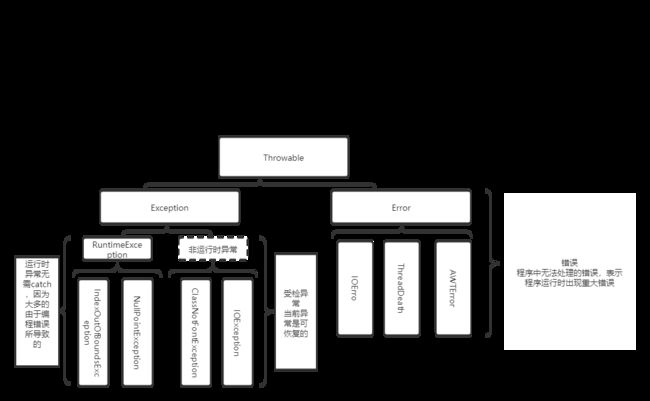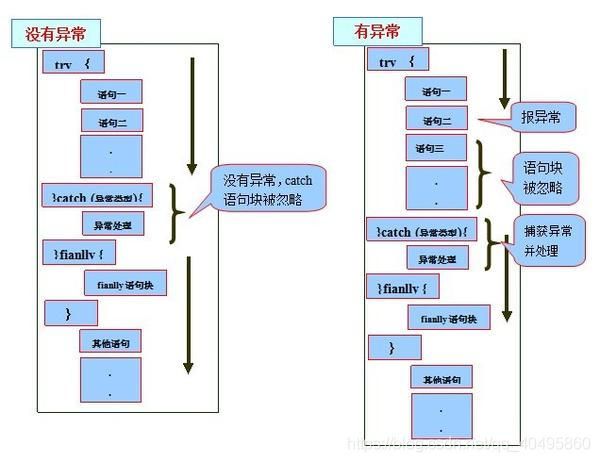Java 异常从精通到陌生
Java 异常从精通到陌生
一.什么的异常?
异常(不同于寻常的)指的是在程序运行过程中发生的异常事件,通常是由外部问题(如硬件错误、输入错误)所导致的。在Java等面向对象的编程语言中异常属于对象。
在Java中通过Throwable类的各种子类来描述不同的异常。
二.为什么使用异常机制
- 可读性
- 可靠性
- 可维护性
三.Java异常层次结构
Throwable
Throwable 是 Java 语言中所有错误与异常的超类。表示任何可以作为异常被抛出的类。
Error
编译时和系统错误,程序中无法处理。
Exception
程序本身可以捕获并且可以处理的异常。
- RuntimeException
四.使用
声明 throws
用于声明改方法可能抛出异常
public void throwsException() throws IOException{
}
抛出 throw
public void throwsException() throws IOException {
throw new IOException();
}
捕获 catch
catch 语句块中可以捕获多个异常类型,并对不同类型的异常做出不同的处理
public void catchException(){
try {
throwsException();
} catch (IOException e) {
//如果不处理可以声明异常继续抛出
e.printStackTrace();
}catch (Exception e) {
e.printStackTrace();
}
}
同一个 catch 也可以捕获多种类型异常,用 | 隔开
public void catchException(){
try {
throwsException();
} catch (IOException | Exception e) {
//如果不处理可以声明异常继续抛出
e.printStackTrace();
}
}
最后 finally
finally用于将资源恢复到它们的初始状态。如:以打开的文件或者网络链接
public void BufferedWriter() {
final File file = new File("C:/Users/TheBlindM/Desktop/gbk.txt");
FileWriter fileWriter =null;
PrintWriter printWriter = null;
try {
fileWriter = new FileWriter(file);
printWriter = new PrintWriter(fileWriter);
while (true) {
printWriter.println("hhh");
printWriter.flush();
}
} catch (IOException e) {
e.printStackTrace();
}finally {
if(fileWriter!=null) {
try {
fileWriter.close();
} catch (IOException e) {
e.printStackTrace();
}
}
if (printWriter!=null){
printWriter.close();
}
}
}
finally总是被执行(不过凡事都有例外) 。
finally遇见如下情况不会执行
- 在前面的代码中用了System.exit()退出程序。
- finally语句块中发生了异常。
- 程序所在的线程死亡。
- 关闭CPU。
try-finally可直接使用
finally内部不建议写return,会覆盖原先的return
try-with-resource
try-with-resource是Java 7中引入的
JAVA 7 提供了更优雅的方式来实现资源的自动释放,自动释放的资源需要是实现了 AutoCloseable 接口的类。
public void BufferedWriter() {
final File file = new File("C:/Users/TheBlindM/Desktop/gbk.txt");
try (FileWriter fileWriter = new FileWriter(file);
final PrintWriter printWriter = new PrintWriter(fileWriter);) {
while (true) {
printWriter.println("hhh");
printWriter.flush();
}
} catch (IOException e) {
e.printStackTrace();
}
}
流程
五.实现机制
异常表
行号
20 public static int throwException() {
21 int x;
22 try {
23 x=1;
24 return x;
25 }catch (Exception e){
26 x=2;
27 return x;
28 }finally {
29 x=3;
30 }
31 }
public static int throwException();
descriptor: ()I
flags: ACC_PUBLIC, ACC_STATIC
Code:
stack=1, locals=4, args_size=0
0: iconst_1 //1(int)值入栈。 对应23行 x=1
1: istore_0 //将栈顶int类型值保存到局部变量0中。
2: iload_0 //从局部变量0中装载int类型值入栈。 对应24行
3: istore_1
4: iconst_3 //3(int)值入栈。 对应23行 x=1
5: istore_0
6: iload_1 //从局部变量1中装载int类型值入栈。 值为1
7: ireturn
8: astore_1 // 将栈顶引用类型值保存到局部变量1中。
9: iconst_2 //2(int)值入栈。 对应26行 x=2
10: istore_0 //将栈顶int类型值保存到局部变量0中
11: iload_0 //从局部变量0中装载int类型值入栈。 对应27行
12: istore_2 //
13: iconst_3
14: istore_0 //
15: iload_2
16: ireturn
17: astore_3 //将栈顶引用类型值保存到局部变量3中。
18: iconst_3 //1(int)值入栈。 对应27行 x=1
19: istore_0
20: aload_3
21: athrow
Exception table:
from to target type
0 4 8 Class java/lang/Exception
0 4 17 any
8 13 17 any
Exception table:异常表
- from 可能会发生异常的起点
- to 可能会发生异常的结束点
- target from to之间发生异常后处理的位置
- type 可以处理的类型
3条异常表对应三条
- 如果try语句块中出现属于Exception或其子类的异常,则转到catch语句处理
- 如果try语句块中出现不属于Exception或其子类的异常,则转到finally语句处理
- 如果catch语句块中出现异常,则转到finally语句处理
问题:
1.如果finally中带return或者catch中带return,会怎样?
如果带return 在字节码中会转化为ireturn(返回int类型值,返回栈顶)
六.编写建议
1.异常应该用于异常的情况下,永远不要应该用于正常的控制流程
2.对于可恢复的情况使用受检异常,对于编程错误使用运行时异常
3. 优先使用标准异常
| 异常 | 使用场合 |
|---|---|
| IllegalArgumentException | 参数的值不合适 |
| IllegalStateException | 参数的状态不合适 |
| NullPointerException | 在null被禁止的情况下参数值为null |
| IndexOutOfBoundsException | 下标越界 |
| ConcurrentModificationException | 在禁止并发修改的情况下,对象检测到并发修改 |
| UnsupportedOperationException | 对象不支持客户请求的方法 |
4.优先捕获最具体的异常
5.不要记录并抛出异常
欢迎关注公众号

参考
深入理解JVM虚拟机
Effective Java
https://www.pdai.tech/md/java/basic/java-basic-x-exception.html

